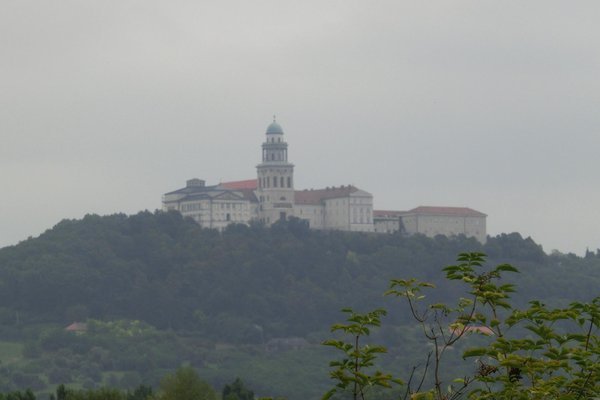Hungary
Pannonhalma
The Millenary Benedictine Abbey of Pannonhalma and its Natural Environment was the first Hungarian Christian monastery and has been influential in the spread of Christianity over Central Europe.
Built on the Sacred Hill of Pannonia, the monastery was founded in 996 when Hungary was primarily a pagan culture. It's an example of an early Christian monastery that still is in use by Benedictine monks. The complex also holds educational buildings, a forest and botanical and herbal gardens.
Community Perspective: The highlight here, in addition to the impressive natural setting, is the 19th-century classicist library. The site usually swarms with tourists. You can move around at your own pace using an audio guide.
Site Info
Official Information
- Full Name
- Millenary Benedictine Abbey of Pannonhalma and its Natural Environment (ID: 758)
- Country
- Hungary
- Status
-
Inscribed 1996
Site history
History of Pannonhalma
- 2003: Name change
- From "Millenary Benedictine Monastery of Pannonhalma and its Natural Environment" to "Millenary Benedictine Abbey of Pannonhalma and its Natural Environment"
- 1996: Inscribed
- Inscribed
- Type
- Cultural
- Criteria
- iv
- vi
Links
- UNESCO
- whc.unesco.org
- Official
-
- pannonhalmifoapatsag.hu — Official website of the Monastery
All Links
UNESCO.org
- whc.unesco.org — whc.unesco.org/
Official Website
- pannonhalmifoapatsag.hu — Official website of the Monastery
Community Information
- Community Category
- Religious structure: Christian
Travel Information
Budapest hotspot
Recent Connections
-
Perfect Inscriptions
1996 -
Depicted in Mizielinska Maps
See i.pinimg.com
-
Roman Province in its official title
Pannonia (= Hill of Pannonia). Created …
Connections of Pannonhalma
- Trivia
- History
-
-
Inscribed in connection with an anniversary
996 / 1996
-
- World Heritage Process
-
-
Perfect Inscriptions
1996
-
- Religion and Belief
-
-
Benedictines
-
Sacred Mountains
Sacred Mount of Pannonia -
Introduction of Christianity
was the first Hungarian Christian monastery (996) and has been influential for the spread of Christianity over Central Europe.
-
- Human Activity
- Timeline
-
-
Built in the 10th century
for "early date of its foundation": It was founded as the first Hungarian Benedictine monastery in 996 by Prince Géza (wiki)
-
- WHS Hotspots
-
-
Budapest hotspot
2h50 by train -
Vienna hotspot
-
- Science and Technology
-
-
Libraries
-
Botanical Gardens
Arboretum
-
- WHS Names
-
-
Name changes
monastery changed to abbey (2003) -
Roman Province in its official title
Pannonia (= Hill of Pannonia). Created c 20ADSee en.wikipedia.org
-
News
No news.
Recent Visitors
Visitors of Pannonhalma
- Adrian
- Adrian Turtschi
- Alexander Barabanov
- Alexander Lehmann
- Anna Wludarska
- anthonybonbon
- Argo
- AS
- Atila Ege
- Attiska
- BaziFettehenne
- Bin
- Bodil Ankerly
- Brendan Carroll
- Bropyk
- Carlos Sotelo
- Caspar
- Cezar Grozavu
- chenboada
- Christer Sundberg
- Christian Wagner
- Claire Bradshaw
- Clyde
- Csaba Nováczky
- CugelVance
- cutecid
- Dagmara
- daneva
- Dan Pettigrew
- David Berlanda
- David Marton
- Dimitar Krastev
- Dimitrios Polychronopoulos
- Dirk-pieter
- Dorejd
- Dr. Caligari
- Els Slots
- Erik Jelinek
- Errol Neo
- Eva Kisgyorgy
- Fan Yibo
- Farinelli
- Feldhase
- Femke Roos
- Filip Murlak
- Frederik Dawson
- Gabor
- Geert Luiken
- George Gdanski
- GeorgeIng61
- Gernot
- Harry Mitsidis
- henrik_hannfors
- heywhatever2
- Hubert
- Hurrvinek
- Iain Jackson
- Ilya Burlak
- Ivan Rucek
- Jacob Choi
- janis
- Jarek Pokrzywnicki
- Jawnbeary
- Jezza
- JobStopar
- Joel on the Road
- John Smaranda
- Jonas Hagung
- Jonas Kremer
- jonathanfr
- Joyce van Soest
- Judit Andrea Juhász
- jxrocky
- KarenBMoore
- Ken DJ
- Kerékgyártó
- Klaus Freisinger
- Krzysztof B
- Kurt Lauer
- kutasp
- Lara Adler
- Lisu Marian
- ljowers
- Luboang
- Lucas Del Puppo
- Luis Filipe Gaspar
- Maciej Gil
- Mahuhe
- Małgosia Łupicka
- marc Rouserez
- Martina Rúčková
- Marton Kemeny
- MatusBeber
- MaxHeAnouBen
- MaYumin
- Michaela0705
- Michael Turtle
- Mikko
- Milan Jirasek
- MMM
- Mohboh
- nan
- Nihal Ege
- Patrik
- Peter Lööv
- Petteri
- Philipp Leu
- Philipp Peterer
- Pincze
- Purrfect
- Rafał Kałczuga
- Randi Thomsen
- Reza
- Rob Wilson
- Roger Ourset
- Roman Bruehwiler
- Roman Raab
- Sabrina Liebehentschel
- Sergio Arjona
- Shandos Cleaver
- Slavi
- Solivagant
- Sorel Americo
- Stanislaw Warwas
- Stijn
- Svein Elias
- Szabolcs Mosonyi
- Szabo Viktoria
- Szucs Tamas
- Tamara Ratz
- Taotao Chen
- Tarquinio_Superbo
- Tcchang0825
- Tevity
- Thomas Buechler
- Thomas van der Walt
- Thorben
- Tim Allen
- Timothy C Easton
- Tonisan
- triath
- Tsunami
- UncleSlavi
- Vanessa Buechler
- Westwards
- Wojciech Fedoruk
- YaroMir
- Yevhen Ivanovych
- Yi Han Goh
- Zhenjun Liu
- Zoë Sheng
- Zos M
- Zsuzsanna Forray
Community Reviews
Show full reviews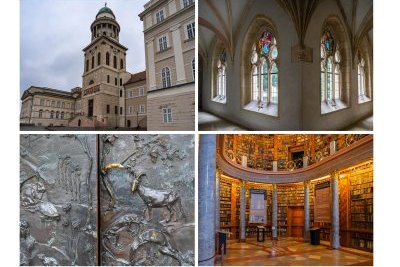
I visited Pannonhalma in November of 2024 by car from Budapest - the drive is about an hour and a half long. The only other visitors that I eventually saw were a group of high schoolers on a field trip, but the upper parking lot did not have a single available space. I was about to drive down the hill to the parking lot near the "visitor information center" when I noticed someone who looked like a repairman employed by the abbey getting into his car parked in the slightly lower-lying area by the south side of the building. That smaller lot is probably not meant for visitors, but there are no impediments to exit or entry, so I counted myself lucky to be able to park that close on a rainy day.
If I turned right from there and walked around the complex clockwise, I would reach the visitor entrance in about a minute from my parking spot. However, despite being familiar with Clyde's review below, I still walked counterclockwise to the main entrance, engaged a woman in an office by the gate in a conversation regarding access to the abbey, and was directed to continue to walk around the building, which in the end meant that I practically circumnavigated it. Somewhat unfortunately, the grandeur of such a complex can only be truly appreciated via aerial photographic shots. The ground-level approach perspectives barely hint at that.
The abbey is over a thousand years old - it was …
Keep reading 0 comments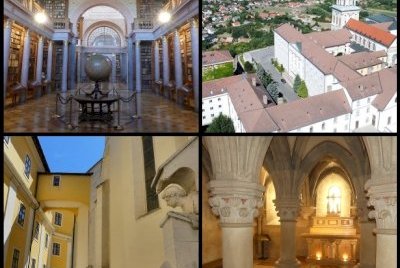
I visited this WHS in 2022 by car en route from Vienna. The usual base is Gyor, but there are also a few guesthouses near the archabbey proper which are better situated to enjoy the archabbey at sunset (best lighting on the golden mosaics of the tower) or after sunrise. It lies on a hill and it is best to park at the upper parking area near the millenium memorial chapel.
Benedictine monks from Breznov (near Prague) arrived to the hill of St Martin in 996. Under the leadership of Abbot Anastasius, they founded a monastery to promote the Christianisation of Hungary. The church was consecrated as early as 1001 and a monastery was built adjoining the church to the south. The current early Gothic style three-nave church of the archabbey was consecrated in 1224. However, archaeological excavations prove that instead of today's church, there was another stone church of almost the same size which was standing already in the times of St. Stephen. The WHS includes the surroundings of the monastery with the Chapel of Our Lady on the hill furthest from the abbey. This single-aisled Baroque church was built between 1714 and 1725 and its crypt is still in use as the burial place for the monks of the monastery. Near this chapel lies a treetop walkway, a panoramic viewpoint, the millenium chapel and just opposite the archabbey an arboretum with lavender fields.
The main entrance to the archabbey is reserved for the monks, with a …
Keep reading 0 comments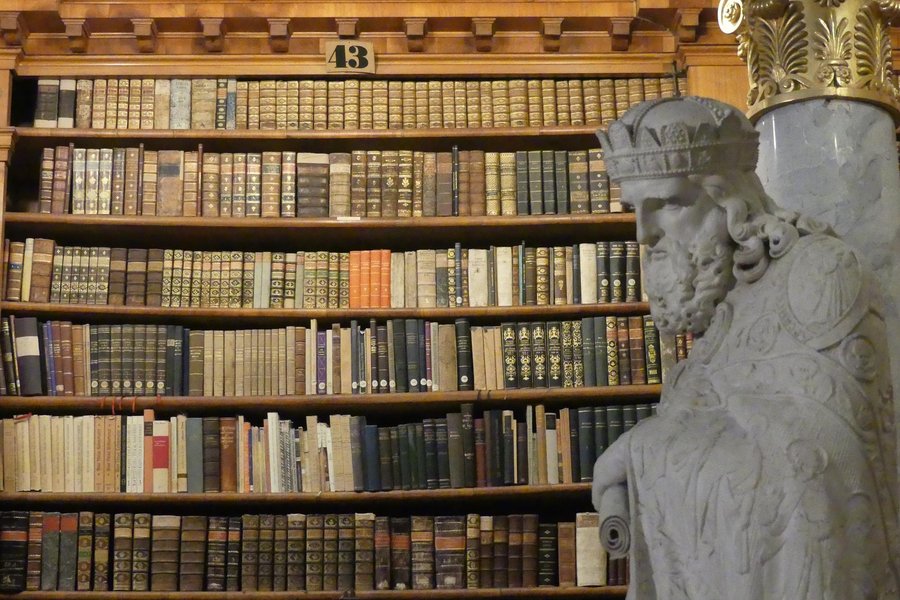
This huge abbey is located on a hill outside of Györ, on the road between Vienna and Budapest. It's one of Hungary's most famous attractions, and it was swarming with tourists when I visited on a beautiful August day. It occupies an important in Hungarian history and culture, and I enjoyed visiting its historic parts, especially the library. Pannonhalma is probably not the most impressive abbey/monastery I have seen, but it is still definitely worth a visit. There are occasional buses from Györ to the abbey (and some more to the village below), but as we went there on a Sunday, we opted for a taxi instead. Most visitors seem to be on organized bus tours, as there is a huge car park next to the visitor centre that was full with coaches from all over Europe.
Keep reading 0 comments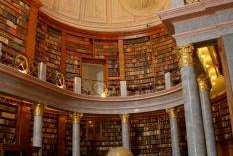
Pannonhalma is one of those sites that I have visited mainly because it is a World Heritage Site.
In April 2013, I spent a few days in Vienna and decided to make a detour to Pannonhalma. From Vienna, it is only about 1.5 hours by car. I reached Pannonhalma at 11 a.m. on a Saturday, besides me there were only two other individual visitors - and four large tour groups.
There is not much I could add to the previous reviews. Thus, this review is primarily to report a recent change: since March 2013 you can visit the monastery on your own, equipped with an audio guide. I think this is an improvement, since the basilica is rather small and the space in the crypt is narrow, so that a visit with a large group is not really a pleasure. Sometimes I had to wait a few minutes until a tour group had left a certain place, but then I had the site all to myself. The audio guide is available in nine different languages and guides you through the basilica, the crypt, the Porta Speciosa, the cloister, and the library. I agree with the previous reviewers, that the library is the best part of the monastery (photo). It is at least as impressive as similar libraries in Vienna, Melk or St Gall.
I also took a walk to the Millenary Monument and the Chapel, both mentioned by David. Unfortunately, the chapel was closed, it is open from June to …
Keep reading 0 comments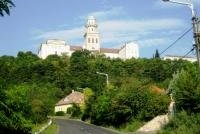
On a hilltop, south of Györ in northern Hungary in the Roman province of Pannonia, a group of monks settled in year 996. They were granted property and privileges by King Stephen and formed the monastery of Pannonhalma that still today carries on its mission today. For its 1000th birthday in 1996 the monastery was thoroughly refurbished and is now one of the most impressive historical complexes in Hungary.
You can not visit the monastery on your own so joining a guided tour is a must. You will then visit the 12th century Basilica of St.Martin, see the 'Deed of Foundation', a document containing the earliest surviving example of written Hungarian and last, but not least, the monasteries impressive private library with over 300.000 volumes. And if it wasn't for a great fire in the early 19th century there would have been even more books. The monastery was one of a few actually working during the darkest days of communism and today it runs the most renowned boarding schools in Hungary.
The landscape around the monastery is filled with vineyards and the sleepy little village of Pannonhalma just below the monastery offers a few B&B's and nice little restaurants that could prolong your stay for a night or two.
Keep reading 0 comments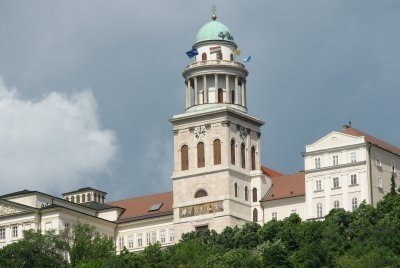
Travelling by local train from Györ, Pannonhalma monastery can be seen from afar. Amidst the grass lands a hill with a conspicuous building on top suddenly appears. I kept turning my head to look at this attractive sight, while the train slowly turned its way. This must be it!
As is the case with almost every monastery on earth there's a climb involved to actually get there. From the Pannonhalma railway station it's about half an hour into town, and then another twenty minutes up to the monastery's visitor center. It's sometimes hard to estimate the popularity of a WHS - some are major tourist sites and many others are obscure monuments seldom visited by the general public. Pannonhalma fits in the first category: it has a large car park for tour buses, a restaurant and there were about 50 other visitors on my tour.
The monastery complex can only be visited with a guided tour. This starts off with a video in which some of the monks explain the lives they live at Pannonhalma. Education is a big part of their life.
The tour then takes us to the main building. On the outside, the 19th-century tower is the most impressive sight. It has a very colourful mosaic picture above the gate.
Inside the church it is rather dark, the only light coming from the glass-tiled windows. The church floor has three levels: for the priests, the monks and the faithful.
The most impressive …
Keep reading 0 comments
In our trip to Hungary we have visited the abbey of Pannonhalma, founded for converting the Hungarians in 996 by the Benedictines supported by the first king of Hungary, Géza, and his son Stephen I. Then was founded the first school in Hungary and written the first document in Hungarian. There took place the peace negotiations between Papacy and Empire (11th century). It was an important cultural centre and it was reconstructed many times (in the end in Baroque style), also for becoming a fort against the Turkish (18th century). Now there is still a school and a monastic community. The church is Romanesque and have a 55 m high neoclassical tower with a dome, constructed by János Páckh. The interior is Gothic with three naves, like the crypt and has beautiful vaults and Renaissance doors. From ambulatory you can go to the square Gothic cloister, that has vaulting, springing from consoles decorated with symbolic motifs, sculptured stones and a door with red marble columns, across the beautiful Romanesque red marble portal, Porta Speciosa, with five pairs of columns. Near that is also the chapel of St. Stephen, the sacristy, with original furniture, the chapterhouse and the refectory, an oblong two-storeyed hall, projected by Martin Witwer, with nice frescos by Antonio Fossati. The archives contain unique documents and the library, built on four levels, is a neoclassical masterpiece with 350000 books and many statues. The buildings of the abbey is two-storeyed; very nice are the vaulted corridor and the row …
Keep reading 0 comments
The monastery is beautiful! It stands proudly on a hill above the village and dominates the whole vista.
It is a long daytrip from Budapest and for the WHS enthusiast is well worth it.
The only down side is that the tour is rather short and limited. It is though worth it just to see the incredible library.
Keep reading 0 comments
Pannonhalma was truly breathtaking in every respect. I visited the monastery on a cloudy March Sunday, 2004. The view of the monastery from the village below was dramatic, as well as there viewing downhill. I felt as though I was in a different world and had stepped back into time. Europe is rich in history, art and architecture compared to USA. The monastery is at the top of the must see sights in Hungary.
Keep reading 0 comments
